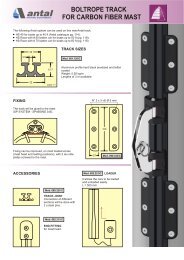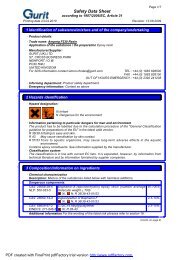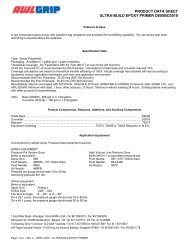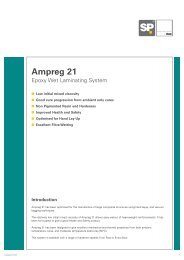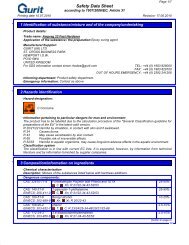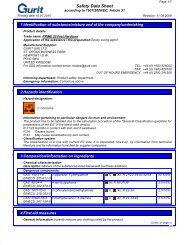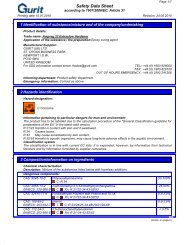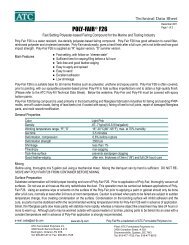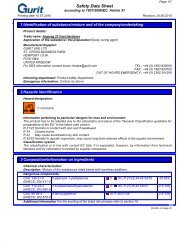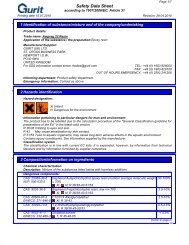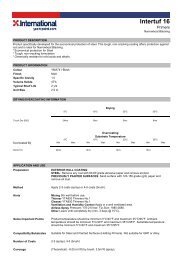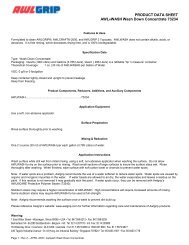SG300 Series - Marineware
SG300 Series - Marineware
SG300 Series - Marineware
Create successful ePaper yourself
Turn your PDF publications into a flip-book with our unique Google optimized e-Paper software.
T E C H N I C A L D ATA S H E E T<br />
<strong>SG300</strong> <strong>Series</strong><br />
Methacrylate Adhesives<br />
DESCRIPTION<br />
SCIGRIP <strong>SG300</strong> <strong>Series</strong> Methacrylate Adhesives are two-component, 10:1 mix ratio products for bonding metals, composites and other plastic parts 1 .<br />
Most metals can be bonded without priming 2<br />
including reduced read through on show surfaces. The combination of minimum surface preparation 1, 2 , primerless metal bonding and low read<br />
through makes the <strong>SG300</strong> series products ideal for a variety of assembly operations. Packaging options include 50 and 490 ml cartridges and 19 and<br />
189 liters (5 and 50 gallon) bulk containers for application with meter-mix dispense equipment.<br />
PERFORMANCE BENEFITS<br />
• Primerless metal bonding No surface treatment or primers required for most metals 2<br />
• Reduced bond line read through<br />
• Choice of 5, 15 and 40 minute working times<br />
• Non-sag application characteristics<br />
• Excellent environmental resistance<br />
• Permanent toughness<br />
TYPICAL ADHESIVE CHARACTERISTICS @ 24°C (75°F)<br />
Reduced post finishing requirements<br />
Selection to fit application and process requirements<br />
Facilitates application on non-level surfaces<br />
Permanent bonds in harsh operating environments<br />
Excellent fatigue, impact and shock load resistance<br />
Characteristics Part A (Adhesive) Part B (Activator) Mix (Part A + B)<br />
Colour Off White Black or Off White Black or Off White<br />
Mix ratio by volume 10 1 —<br />
Mix ratio by weight 8.75 1 —<br />
Density, g/cc 1.01 1.15 1.02<br />
Density, lb/gallon 8.40 9.60 8.51<br />
Viscosity, cps 190,000 – 250,000 50,000 – 150,000 —<br />
TYPICAL PHYSICAL PROPERTIES @ 24°C (75°F)<br />
Tensile Strength MPa (psi) 14 – 15 (2,000 – 2,200) Lap Shear Strength 4 MPa (psi) 17 – 19 (2,500 – 2,800)<br />
Maximum Tensile Elongation (%) 100 – 125 Service Temperatures °C (°F) -40 to 82 (-40 to 180)<br />
Tensile Modulus 3 MPa (psi) 207 – 276 (30,000 – 40,000)<br />
RECOMMENDED SUBSTRATES<br />
Composites Metals 2 Thermoplastics 1<br />
✓ Epoxy ✓ Aluminum ✓ ABS<br />
✓ ✓ Carbon Steel ✓ Acrylics<br />
✓ Vinyl Ester ✓ Stainless Steel ✓ PVC/CPVC<br />
✓ Gelcoats ✓ Coated Metals ✓ Styrenics<br />
PRODUCT PROPERTIES @ 24°C (75°F) – Fixture Time (time to achieve 1.4 MPa or 200 psi strength in lap shear) 4<br />
Cartridge Adhesive / Activator Working Time (minutes) Fixture Time (minutes)<br />
<strong>SG300</strong>-05 SG305 A / SG605 B 4 – 6 >15<br />
<strong>SG300</strong>-15 SG315 A / SG605 B 13 – 17 >30<br />
<strong>SG300</strong>-40 SG340 A / SG605 B 35 – 45 >80<br />
NOTES:<br />
1.<br />
2. Prepare metal by removing dust, loose scale, rust and other surface residue including oil and grease. For maximum bond strength on steel, abrade surface prior to bonding. See<br />
important notes a, b and c on reverse side.<br />
3. Tensile modulus as measured in the linear portion of the stress strain curve.<br />
4. Lap shear strength of unprimed aluminum to aluminum bond based on ASTM D 1002 method.<br />
SCIGRIP Europe,<br />
scigrip.com<br />
TDS <strong>SG300</strong> 03/11
Combining the best of breed into one dynamic new brand<br />
SAFETY AND HANDLING<br />
Read Material Safety Data Sheet before handling or using this product. Adhesive<br />
use in a well-ventilated area. Floor-level extraction and large quantities of<br />
moving air greatly facilitate ventilation. Both materials must be stored in a cool<br />
closed when not in use. Prevent contact with skin and eyes. In case of skin<br />
15 minutes and seek immediate medical attention. Harmful if swallowed. Keep<br />
out of reach of children.<br />
MIXING AND APPLICATION<br />
EXOTHERM: The chemical curing reaction that occurs when components A and<br />
B are mixed generates heat. The amount of heat generated is dependent on the<br />
mass and thickness of the mixed product. Large masses over 1.5 inch (39 mm)<br />
thick can develop heat in excess of 250°F (121°C) and can generate vapors that<br />
should be avoided from direct personal contact.<br />
CURING<br />
Open working time is the approximate time after mixing components A and B,<br />
Fixture time is the approximate time after mixing components A and B required<br />
for the adhesive to react the partial state of cure necessary to allow careful<br />
movement, unclamping or de-molding of assembled parts. Parts can generally be<br />
put in service when 80 percent of full strength is developed. The time to achieve<br />
at 75°F (24°C). Higher temperatures speed the curing reaction and reduce open<br />
in temperatures or application at very high or low temperatures is anticipated,<br />
contact your SCIGRIP representative for technical assistance.<br />
DISPENSING EQUIPMENT<br />
Dispensing from disposable cartridges or meter-mix dispense equipment is<br />
highly recommended. Both methods employ convenient static motionless<br />
mixer technology. Product supplied in pre-measured cartridges is dispensed<br />
from approved manual or pneumatic powered guns. While using pneumatic<br />
dispensing guns, it is mandatory to use the gun’s regulator to regulate the air<br />
pressure. Manufacturers recommended maximum operating pressure and<br />
maximum compressed air supply pressure are 85 and 120 psi respectively.<br />
Removal of the regulator from the dispensing unit can lead to over pressurizing<br />
and rupture of the cartridge cylinder. Contact your SCIGRIP representative for<br />
information and availability.<br />
When meter-mix dispense systems are used, care must be taken to assure<br />
compatibility between the adhesive components and the materials in the<br />
equipment that they contact. All wetted metal components should be constructed<br />
material that prevents contact between the adhesive components and the base<br />
metal. Contact with copper, brass, zinc or alloys containing these materials must<br />
be strictly avoided. All non-metallic seals and gaskets should be fabricated from<br />
®<br />
, or polyethylene based materials. Natural rubber, nitrile rubber (BUNA),<br />
neoprene and Viton ® are not acceptable.<br />
APPLICATION<br />
Follow instructions provided or contact your SCIGRIP representative for proper<br />
preparation of dispensing equipment and substrates prior to starting the bonding<br />
process. Always dispense a quantity of adhesive at start-up to assure that the<br />
adhesive exiting the tip of the mixer is the proper color and is uniform, without<br />
streaks. If aged material is being used, allow the purged material to cure to<br />
when the parts are mated. Allow for squeeze-out at the edges of the bond to<br />
the adhesive sets. Do not apply excessive pressure that can cause excessively<br />
thin gaps and starve the bond line. If in doubt, use shims or spacers to set the<br />
gap. A minimum gap of 0.02 inch (0.50 mm) is recommended for all other<br />
is required, we recommend that it is carefully performed using alcohol or other<br />
preferred industrial solvent while the adhesive is still wet or soft. Partially cured<br />
adhesive can be carefully removed with a sharp knife. Cured adhesive must be<br />
sanded or scraped, using a suitable solvent to remove remaining traces.<br />
CLEAN UP<br />
Adhesive components and mixed adhesive should be removed from mixing<br />
and application equipment with a suitable industrial solvent or cleaner before<br />
the mixed adhesive cures. Once the adhesive cures, soaking in a strong<br />
solvent or paint remover will be required to soften the adhesive for removal.<br />
2088 is recommended, or contact your SCIGRIP representative for additional<br />
information. Any clean-up of the bonded assembly using industrial solvents is<br />
not recommended as it could affect the cure.<br />
STORAGE AND SHELF LIFE<br />
The shelf life of components A and B in unopened containers is approximately<br />
six months from the date the product is shipped from SCIGRIP facilities. Shelf<br />
life is based on steady state storage between 55°F and 80°F (13°C and 27°C).<br />
Exposure, intermittent or prolonged, above 80°F (27°C) will result in a reduction<br />
of the stated shelf life. Exposures above 100ºF (38ºC) during shipping or storage<br />
can quickly degrade component B in cartridges or bulk containers, and must be<br />
prevented. Shelf life of both components can be extended by air-conditioned<br />
or refrigerated storage between 50°F and 65°F (10°C and 18°C). KEEP FROM<br />
FREEZING.<br />
IMPORTANT NOTES<br />
a. SUBSTRATE AND APPLICATION COMPATIBILITY: The user must determine the<br />
suitability of a selected adhesive for a given substrate and application. SCIGRIP<br />
strongly recommends laboratory, shop and end-use testing that simulates the<br />
actual manufacturing and end-use environment.<br />
b. SURFACE PREPARATION: The need for surface preparation must be determined<br />
by comparative testing of prepared and unprepared substrates to assure that<br />
unprepared bonding is equivalent to or acceptable for the application relative<br />
to prepared bonding. Initial bonding tests must be followed up with simulated<br />
or actual durability tests to assure that surface conditions do not lead to<br />
degradation of the bond over time under service conditions. Subsequent<br />
changes in substrates or bonding conditions will require re-testing.<br />
c. TECHNICAL ASSISTANCE: Contact your SCIGRIP representative for questions<br />
or assistance with the selection of adhesives and methods for evaluating<br />
adhesives for your intended application.<br />
NOTE: This product is intended for use by skilled individuals at their own risk.<br />
Recommendations contained herein are based on information we believe to<br />
be reliable. The properties and strength values presented above are typical<br />
properties obtained under controlled conditions at the SCIGRIP laboratory. They<br />
are intended to be used only as a guide for selection for end-use evaluation.<br />
The ultimate suitability for any intended application must be verified by the end<br />
user under anticipated test conditions. Since specific use, materials and product<br />
handling are not controlled by SCIGRIP, our warranty is limited to the replacement<br />
of defective SCIGRIP products.<br />
SCIGRIP Europe,<br />
scigrip.com<br />
TDS <strong>SG300</strong> 03/11



